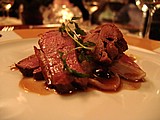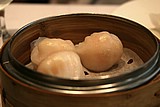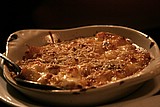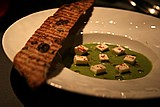Home |
Restaurants by City
|
Food Photography |
Archive | Philosophy |
![]()
Right now we are eating in Seattle, Washington.
|
Wednesday
2004
Permalink
|
Daniel, New York, NY, tasted on February 19, 2004 — A couple of years ago I read the book The Fourth Star - Leslie Brenner's book on Daniel Boulud's successful attempt to earn his fourth star from the New York Times for his eponymous restaurant. The book sometimes gets confusing, but I think that's testament to the multi-tasking going on in the kitchen when things really get going. And we got plenty of views of the kitchen during our most recent meal at Daniel. I am lucky in that I get to eat out a lot. After awhile you start to notice patterns. Something that seemed pretty exciting, novel, and tasty at one restaurant, all of a sudden feels banal after you've eaten it at the fifth place. This is why in general I respond the most positively to food that is simple. Too many restaurants fill a plate with a bunch of "stuff" trying to be "interesting" and "creative". In the end these dishes often end up being distracting and muddled. Sometimes I feel like chefs use a multitude of ingredients to cover up the fact that their food has no soul. And even if that's not their intent (as most chefs I'm sure at least feel like they're trying to do something special) it often is the result. It would be silly to say that fewer ingredients and simpler dishes always make for better food. Though statistically it certainly does feel that way. I think the real issue is that there's a unique skill in combining many ingredients and keeping the dish coherent. And there is exceptional skill in combining a multitude of ingredients and conveying some sort of soul. The first time I ate there it threw me for a loop. I almost didn't know what to make of it. But this second time, I figured it out. I apologize in advance for not being a better writer, but the best way I know how to describe it is that a clear warm bell-like tone of a rich tenor permeated just about every dish we ate at Daniel. This is not to say it was a monotone. It was just a deep flavor that resonated across almost every dish. It also served as a strong foundation for the frequent spikes of flavor that appeared in different dishes. I know it sounds odd to describe food in this way, but it's the best I can do. This was all the more impressive given that Boulud isn't regularly cooking there anymore. Instead the kitchen is now run by Jean François Bruel. Dinner started off with a glass of Kir Royale. A combination of Champagne and Creme de Cassis in champagne flutes. Sort of like an alcoholic Shirley Temple. Once the champagne was flowing, a three tier silver tray showed up with a huge number of amuse bouche. Parmesan and Goat Cheese with Pine Nuts in pastry shells - awesome flavor with a tangy cheesey concentrated yumminess. Foie Gras Mousse with Huckleberry - maybe the best foie gras pate I've ever eaten. It was creamy and almost liquid and had a perfect temperature - not too cold. Definitely had that warm undertone of flavor. There was also Chummus and Gougeres. The chummus had a fresh neat flavor (I'm hard to please on the chummus front) and the gougeres were little puffy airy balls of goodness. There was also Oyster Veloute with Lemongrass. The oyster had milky, creamy, briney flavors and great tannins. The caviar was a subtle balancing flavor but the oyster was still the star. And finally there were mini quiches - they were custardy with an almost molten center even though they were served at room temperature. Soon after a basket of a variety of breads showed up. Just like last time we were there the selection was large, and the quality great. They included: garlic rosemary, black olive, and rustic sourdough. The garlic bread had a salty goodness on the outside with a cheesey roast garlic flavor inside where there was actual roast garlic embedded in the bread. Kickass. The rosemary olive bread was also good with super present flavors. Next up was Foie Gras Terrine with Gala Apples, Shallot Confit in Cider Vinegar and Endive Walnut Salad. The shallots and gelee were bursting with flavor. Shallots and apples are a great combination. We also got Scottish Pheasant and Foie Gras Terrine with Spiced Chestnuts, Pickled Root Vegetables, Black Truffle Coulis, and Spinach Salad. As good as the first terrine was, the pheasant terrine was even better. It included a new flavor - a gamey, savory goodness. The condiments were nice but I just wanted more of the pure pheasant flavor. After the foie gras course we moved on to a first round of seafood. First was Citrus Marinated Fluke with Cumin, Hearts of Palm Salad, Shiso Cream, and Lemon Balm Oil. The fluke was interesting. It was followed by Maine Sea Scallop Ceviche with Basil Pesto, Blood Orange Nage, Pine Nuts, and Avocado. The scallop was very good with the blood orange and had a good "dry" flavor that I couldn't identify. We were just getting started with seafood. Seared Tuna with Truffles showed up. The dish had an amazing grilled flavor and lovely truffles on the finish. More showed up soon after including Roasted langoustine with Orzo - the stock was super rich and delicious. It filled my mouth. Not to be outdone we also ended up with Black Truffle Crusted Lobster with Ten Winter Vegetables, Savoy Cabbage, Truffle, and Lobster Cream. Lobster with crumbled and shaved truffles. In general that's a no-lose combination. But it wasn't just the luxury of the ingredients that made the dish great, it had that same rich canvas of warm full comforting flavor on which to feature the lobster and the truffle tastes. The components of these dishes are complex, but the deep warm flavor that results is accessible and delicious. The pacing for dinner could have been perceived by some as a touch slow, but for us the breaks were nice as this meal was a marathon, not a sprint. Just when we'd caught our breath, we were served Potato Gnocchi in Meyer Lemon Sauce with Smoked Red Mullet Eggs Bottarga (bottarga?). The lemon was super sublte in the dish. The caviar was so generous (can you be overly generous?) that it almost overwhelmed the dish (I saved a bunch for the end). And just to mix things up a bit we also got Potato Gnocchi with Black Truffle in a Crayfish Emulsion. The combination of the truffle/crayfish/stock was another complex but focused set of flavors, and very good. We'd seen the classic dover sole dish traveling by many times on it's way to another table, and then it finally arrived at our table - Dover Sole with Porcini Mushroom and Black Truffle Perigord Sauce. The sole was delicious. The fish had a great flakey but solid texture. Seared tuna made its second appearance of the evening as Seared Tuna a la Plancha with Exotic Peppercorns, Parsnip Mousseline, Glazed Salsify, and Shallot Confit in Port Wine (looks simpler than it sounds). I've been to many French restaurants where the sauces overwhelm the dishes. At Daniel they are really the baseline for each dish. And in this case the tuna was perfectly cooked. And accompanied by the flavorful port sauce, it was impossible not to enjoy. And all throughout the evening, each person in the kitchen was their own ball of intense energy. Some were quiet and restrained, others a little more wild (relatively). How nothing broke with all the movement and hard work, I don't know. There appeared to be just enough room for everything to happen without disaster. Next up was Muscovy Duck a l'Orange wiuthh Braised Red Endive, Black Olive, and Polenta. This dish was so juicy, and so hearty but had a focused perfect duck flavor. Definitely not overwhelming. Just about every dish we ate had restrained refined flavors with layers of detail piled on one another to form a seamless chorus. Each layer peeled away would reveal another beneath. This was also true of the Roasted Milbrook Farm Venison Loin with Honey-Juniper Glaze, Kabocha Squash, and Chestnut-Celery Chartreuse. This venison was among the juiciest I've ever eaten and had an almost port flavor. The accompaniments were enjoyable as well with the chartreuse reminding me of my mom's flavorful not overly dry or juicy turkey stuffing. Nice. I think that society generally frowns on licking your plate at a restaurant. Alex tried it and one of the chefs glanced over at just the right moment to catch him. It was clear from the smile, that Alex' attempt to extract the last bit of flavor still trapped on his dish was taken as a compliment. What's dinner without a cheese course and a series of exciting and delicious desserts. On the cheese front we had several that stood out including the Livarot from Normandy which was nutty, tangy, and strong but not overly acute (it was our best new discovery). The epoisses, talleggio, and brin d'amour were all excellent as well (no surprise there). The dizzying array of complicated and tasty desserts - here, here, here, here, here, here, here, and here - almost buried us. These of course were followed by crepes - luxuriously sweet, and possibly my favorite dessert at Daniel (and their simplest) - Madelines. At Daniel they had a lemony lightness that was unbeatable. (Don't forget the petit fours.) Daniel is a funny restaurant. The size both of the physical space as well as the ambition are such that many people want to knock it off the pedestal that it's perched itself so proudly upon. But if you eat there a couple of times, you realize that the food really is unique and special even with genetics rooted firmly in the tradition of the high end French restaurant. And the special quality is this ability to combine a bunch of ingredients on each plate, and many plates in one meal, and somehow weave a thread throughout the entire meal. A thread that envelops you with warmth and comfort. Luxurious French comfort food? A meal at Daniel might not be the first thing that comes to your mind with that phrase, but it is for me. |
|||
Our Sponsors
Online Loans – Conversion Strategies – College Courses – Surprise Birthdays – Online Trading - Calendar and Event Schedules - Food Events and Calendars - Wine Events and Calendars - Digital Photography Resources - Jewish Gifts and Judaica - Howard Stern Podcast ponytailed blogger Jonathan Schwartz

Browse tastingmenu
Home |
Restaurants by City X |
Food Photography |
Archive | Philosophy |
![]()
Free eBooks: All About Apples
| Autumn Omakase
More:
Discussion |
Cool Food T-Shirts |
Ingredients
| Markets |
Recipes
Search |
Blog FAQ |
Other
Blogs
Best of tastingmenu
|
City View
Entry: July 6, 2006 |
Blue Plate
Entry: June 19, 2006 |
L'Atelier de Joël Robuchon
Entry: July 18, 2006 |
Browse by City
Boston | Chicago | Houston | Las Vegas | Los Angeles | Maui | New York | Philadelphia | Portland | San Francisco | Seattle | Toronto | Utah | Vancouver | Washington D.C.
Bangkok | Beijing | Hong Kong | Seoul | Tokyo
Amsterdam | Berlin | Italy | London | Madrid | Paris | Vienna
Browse by Month
2006
2005
2004
2003
2002
2001
Comments, questions, or feedback:
info / at / tastingmenu / dot / com
All pages Copyright (c) 2001-2006 tastingmenu.com
Last modified 11/27/06.




